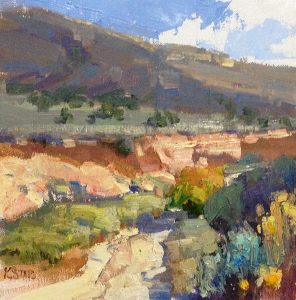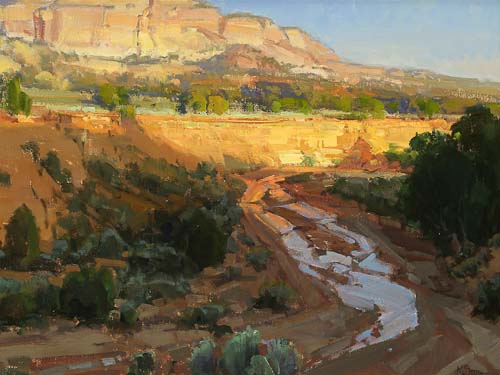(Chapter Excerpt from Making Rain Where the Sun Shines — Lawyers are Supposed to be Golfers — Paying My Dues as a Country Lawyer)
 Regardless of the relatively warm acceptance of the Kane County Water Conservancy District elsewhere, including Cedar Mountain, initially the water conservancy district was not as well received in Johnson Canyon (a large “canyon,” encompassing a fairly large area stretching from Hwy 89A on the south, to Skutempah and the Glendale Bench on the north). In addition to being the situs for armed altercations over trespassing cattle, Johnson Canyon was also the main hot spot for ongoing water disputes in Kane County. Although the Canyon had a well-developed reputation for water fights, including the then pending, longstanding dispute between Hek MacDonald and Sysco Jackson, during my tenure with the Kane County Water Conservancy District, one of Johnson Canyon’s most notable sons and notorious rabble rousers was Kelton Bigler — the Johnson Canyon Water Prophet.
Regardless of the relatively warm acceptance of the Kane County Water Conservancy District elsewhere, including Cedar Mountain, initially the water conservancy district was not as well received in Johnson Canyon (a large “canyon,” encompassing a fairly large area stretching from Hwy 89A on the south, to Skutempah and the Glendale Bench on the north). In addition to being the situs for armed altercations over trespassing cattle, Johnson Canyon was also the main hot spot for ongoing water disputes in Kane County. Although the Canyon had a well-developed reputation for water fights, including the then pending, longstanding dispute between Hek MacDonald and Sysco Jackson, during my tenure with the Kane County Water Conservancy District, one of Johnson Canyon’s most notable sons and notorious rabble rousers was Kelton Bigler — the Johnson Canyon Water Prophet.
Kelton had been raised on one of the small farms in the mouth of Johnson Canyon. By the time I got to know him, Kelton lived in town and was many years removed from his agricultural roots in the canyon. Although at that time Kelton had very minimal property or water holdings in the canyon, that didn’t stop him from being an activist; an outright Evangelist, in his gospel, his one man church of Utah Water Law.
While most people in Kane County seemed to think that all the big water wars had been fought and resolved years ago, and had therefore moved on to things like roads and access rights as the new frontier to focus the majority of their fighting attention on, Kelton never got past water. To Kelton Bigler, water and water law were pure religion. He had essentially devoted his whole life to it. Kelton pursued his hydro faith with the fervor of a zealot, regardless of whether the specific, water-related situation had anything to do with him personally, or not.
Unlike most areas in Utah and throughout the West that eventually formed irrigation and mutual water companies, ultimately recognizing that they could accomplish more by trying to work together and pooling their resources than they could by fighting each other and going at it completely on their own, the farmers, ranchers and property owners in Johnson Canyon had never been capable of such cooperation or organization. Although most of its residents had a hard enough time getting along together as it was, Kelton Bigler continually tried to stir them up, pitting one against the other, and faithfully protesting virtually every water change application filed in the canyon. In addition, he personally attempted to police everyone’s water use, and continually threatened to push the issue regarding any water that wasn’t put to full beneficial use under the law, and thus subject to possible forfeiture for arguable non-use.
The natural landscape of Johnson Canyon has changed fairly significantly over time. When the first settlers arrived, there was no wash in the mouth of the canyon like there is today. At that time, the mouth of the canyon was blessed by a high water table. Much like Kanab Creek, that the original settlers could easily step across when they arrived, the stream that ran down Johnson Canyon didn’t run past the mouth of the canyon, where it spread out to create a broad, subirrigated meadow, covering several hundred acres.
Then, one particularly wet year, when the excess water created problems for the farmers and ranchers in the mouth of the canyon trying to get their hay up, one of them took a plow and plowed a long furrow down through the mouth of the canyon to help drain off the excess water. Over time, the little furrow plowed to help drain the excess water out of the mouth of the canyon, eroded and deepened into a gigantic wash, a veritable abyss, with a small, little stream at the bottom.
According to the infamous Chidester Decree (the original court order apportioning the surface water in Johnson Canyon), the court found that at the time the decree was issued, there were 15 cfs or “second feet” (that would be 15 cubic feet of solid water passing per second) of water running through the wash to the mouth of the canyon, to be apportioned among the lower users. Fifteen second feet is definitely enough water to get in a good fight over, but in the water law business, I quickly learned the difference between actual wet water, and paper water.
The Chidester Decree went on to establish priority dates (first in time, first in right) among the users; determined how many acres they were each irrigating, and; apportioned the purported stream flow among them accordingly, based on their priorities and beneficial uses of the water. At the time the decree was issued, there were many acres of lush, green, productive fields in the mouth of the Canyon. By the time Kelton was growing up in the mouth of the canyon some years later, there were still several very productive little farms and ranches that all relied on surface water from Johnson Wash for irrigation.

By the time I arrived in Kanab, however, much like Kanab Creek, which, as a result of flooding and erosion, was then just a tiny stream at the bottom of a massive arroyo, things looked quite a bit different in the mouth of Johnson Canyon. On either side of the big wash were now just big, dry dusty flats, covered with sage brush and weeds, with several small fields irrigated primarily with well water on the east side of the wash. Much of what had once been lush alfalfa fields was now covered with thistles and tumble weeds, and Johnson Wash was a big, deep, nasty, gaping scar all the way up the canyon, but particularly from Flood Canyon down along the west side of the old Sherman Jensen, Von Hoeppel, and Little Ranches.
During the course of more than a century since the first drainage furrow had been plowed down through the Canyon, the wash had eroded and deepened to the point that it had consumed much of the valley floor, and substantially lowered the standing water table in the entire Canyon. This in turn dried up some of the springs that fed the stream, and the stream itself had been reduced from a hearty and substantial 15 second feet, to a summertime trickle of a fraction of that amount.
As the water table dropped and the stream dried up, so did the fields in the mouth of the Canyon. As the stream and surface water dried up, more groundwater was pumped from wells, developed to compensate for the lack of surface water, which in turn further dropped the water table, and diminished the stream flow even further. This created a perpetual cycle that fed itself, but consumed essentially all the surface water and completely destroyed the high water table that once blessed the mouth of Johnson Canyon.
Although a good share of the erosion resulted from natural processes that took many years, according to local legend, Kelton Bigler himself was primarily and singularly responsible for a substantial amount of the most serious erosion in the lower Johnson Canyon Wash. From the convergence of Flood Canyon into the main canyon itself, on up the Canyon, a very large, interesting and unique rock formation slowed the stream and served as a natural spillway, to let the water down to the lower elevation at the bottom of the wash, essentially preventing any more serious erosion up the canyon.
According to the legend, at some point in time, back in about 1959, Kelton had become so personally dissatisfied with the stream flow in the wash, and had become so convinced that the way to increase the stream flow was to remove part of the rock formation that impeded the flow, that he took it upon himself to blast out a big chunk of the rock with dynamite, to increase the flow. Although Kelton’s handi-work did increase the stream flow (temporarily), apparently the dynamite took out a much bigger chunk than even he had expected.
The effects of that one act (coupled, I suppose, with the original furrow down the canyon), compounded by flooding and the powerfully erosive forces of water, especially over a long period of time, forever changed, and irreparably damaged the mouth of Johnson Canyon, directly causing the vast majority of serious erosion in the wash and on down the Canyon.
From what I could tell, however, following his blasting episode, Kelton was essentially run out of the canyon. Consequently, he maintained very minimal property or water holdings in the Canyon, which were on the far south side, across the highway, essentially completely out of the Canyon itself. But that didn’t stop Kelton from continuing to be a water activist; an evangelist in his one-man water church.
As time passed, and most of the old-timers died and/or went away, despite his minimal personal real estate interests and property holdings in the canyon, Kelton returned, both in person, and in spirit to Johnson Canyon, through the mountains of documents he generated with his trusty old manual typewriter.
When the Utah State Division of Water Rights issued its Proposed Determination in the General Adjudication of all the waters in the Kanab Creek and Johnson Wash Drainages in 1974, Kelton filed massive objections, along with repeated pro se lawsuits, which went on to burden the judicial system of the Sixth District Court with motions, counter-motions, and hearings, for years to come.
 Kelton was a perfect example of the saying about a little bit of knowledge being a dangerous thing. Not that Kelton didn’t know plenty about water, water rights and Utah Water Law; he was self-taught, and had probably forgotten more about those subjects than almost anyone else (including the lawyers) in Kane County would ever know. But he had become very radical in his grasp, understanding and zealous embracement of it.
Kelton was a perfect example of the saying about a little bit of knowledge being a dangerous thing. Not that Kelton didn’t know plenty about water, water rights and Utah Water Law; he was self-taught, and had probably forgotten more about those subjects than almost anyone else (including the lawyers) in Kane County would ever know. But he had become very radical in his grasp, understanding and zealous embracement of it.
What Kelton had just a little knowledge of, which he wielded very precariously and dangerously, was his understanding of the legal system and legal processes. He had a fixation on big words and legalese. His pro se style was a perfect example of the old adage that “if you can’t dazzle ‘em with brilliance, baffle ‘em with B.S.” With the assistance of his faithful manual typewriter, Kelton generated enough paper B.S., in the form of pleadings, motions, notices, requests, and other miscellaneous filings to baffle even the most astute and understanding judges.
One of Kelton’s typical filings read something like this:
“Now therefore, Plaintiff Petitioner hereby respectfully submits a petition requesting an immediate petition for rehearing, forthwith, to ascertain whether Petitioner’s previous petitions for rehearing have been granted nunc pro tunc, and/or to fully adjudicate the issue of whether Petitioner’s previous aforesaid petitions, including but not limited to, interrogatories to the first party of the second part, constitute appropriate voir dire examination within the scope and perview of the applicable rules, for which Petitioner is duly entitled to specific relief, including sanctions, based on the second party of the second part’s failure and refusal to respond to Petitioner’s outstanding discovery requests, in accordance with the applicable statutory, regulatory and adjudicatory provisions governing this instance.
As a general rule, it took someone much more discerning than I was to really even begin to grasp what he was talking about.
Moreover, the older he got, the more Kelton started reverting back to actual guerilla “waterfare” on the ground as well. Kelton’s brother, Lawrence, who had moved to California, still had extensive water and property holdings in the Canyon. To justify and bolster his water activism, and keep things stirred up on the ground, in the trenches, or in the ditches, as the case may be, Kelton started trying to ride herd on Lawrence’s water rights, to insure that there were no encroachments on Lawrence’s surface water rights, and that they didn’t lapse for non-use under Utah’s “use it or lose it” water policy.
To that end, in the Spring of the year, while there was still a pretty good stream flow in the wash, Kelton would first go around burning all the ditches in the mouth of the canyon, including those that crossed anyone else’s property (can you imagine the horror of Kelton Bigler traipsing around your property with a box of matches and a can of gas?). Then he would hook his old Ford 8N tractor, with a three-point hitch scraper on the back to use as a make-shift ditcher, onto his little blue Dodge Colt hatchback and drag the tractor at about 5 mph (he could have driven the tractor faster) from his house in Kanab out to Johnson Canyon, to use, running around on everyone else’s property, trying to clean out the ditches. He did this in an effort to help some of the dwindling stream flow in Johnson Wash find its way clear down to Lawrence’s property, and put the water to beneficial use through irrigation.
During Kelton’s irrigation stint each Spring, keeping track of surface irrigation water in the Canyon was a virtual impossibility, especially at night, when Kelton worked with the moon as his lantern. Calvin Hepworth would divert the stream to water his pasture in the evening, then go home to bed in town. When he’d come back out to check it the next morning, there wouldn’t be any water. So he’d walk the ditch to see where it had gone. He’d usually find it diverted to one of Lawrence Bigler’s old, worn-out fields, watering a patch of weeds. He’d change it back to his own field, then as soon as he was gone, Kelton would come along and change it back, or divert it somewhere else.
 It’s a good thing they never seemed to run into each other there on the ditch, or they probably would have resolved it the good old-fashioned way; the way a lot of water disputes have been settled in the West — with a Scottish lawsuit — a fist fight or a butt stroke with a shovel (if neither one nor both of them happened to be packing any more serious “iron” at the time; people have been known to get killed in disputes over irrigation water in the West).
It’s a good thing they never seemed to run into each other there on the ditch, or they probably would have resolved it the good old-fashioned way; the way a lot of water disputes have been settled in the West — with a Scottish lawsuit — a fist fight or a butt stroke with a shovel (if neither one nor both of them happened to be packing any more serious “iron” at the time; people have been known to get killed in disputes over irrigation water in the West).
Just because Kelton tried to look after Lawrence’s water rights, however, didn’t mean the Bigler family always saw eye to eye when it came to water, even within their own ranks. Kelton and Lawrence had sided together for years in bitter litigation, against their sister, Gladys Little, which had gone all the way to the Utah Supreme Court, several times. Luckily, that all got started way before my time, and fortunately, I never got involved.
But, it was in his capacity as a self-taught and unlicenced water lawyer that I first came to know Kelton. Initially Kelton and his brother Lawrence had retained me to make some minor filings and appear at a particular hearing in the long-pending general adjudication, before ultimately informing me (after I had shown Kelton what to do) that they weren’t willing to spend any more money on it, particularly when Kelton was so capable and willing to do the legal work himself, for free.
Despite firing me, to assist in his research and haphazard document preparation on his manual typewriter, Kelton wasn’t bashful about continuing to ask for help and trying to pick my brain every chance he got, especially once I started doing work for the water conservancy district. In his way of thinking, if I did any work for the water conservancy district for which I got paid, that meant I was on the public dole, and since he paid taxes just like everyone else, my time and advice (a lawyer’s stock in trade), were his for the asking. Consequently, it was not uncommon for Kelton to regularly come by the office completely unannounced, to run various ideas and theories past me, and seek further direction. If I happened to be tied up, he didn’t seem to mind; he realized that he hadn’t bothered to make an appointment, so he would just sit down and wait until I was available to visit with him, no matter how long that took.
There were several distinct challenges with all this. The first challenge was that Kelton thought and talked way over most people’s heads (including mine), and apparently you had to think like Kelton (which no one else I knew, particularly including myself, did) to really understand him, so it was very difficult, if not impossible, to fully grasp what he was even talking about most of the time.
“I’m sorry to drop by without an appointment,” Kelton would sputter, when I finally broke free, showering my face with bits of foamy saliva in his excitement, “but I just need a few minutes of your time to hear what you think about my latest strategy in the General Adjudication.”
“Well, I’m kind of pressed for time right now, Kelton; what would be the chance of having you make an appointment to come back early tomorrow morning?”
“Oh, this’ll only take a minute; I promise,” he would say, showering me again, even as I was toweling myself off from the first dowsing.
“Alright then. Just a minute.”
“Well, just to give you a little background,” he’d start out, talking a million miles a minute. “I guess I must have slipped up and didn’t get a protest filed against Hek MacDonald’s change application on Water User Claim Number 85-328. . . . I must have been out of town or something at the time. . . . But I did file an objection to that claim in the general adjudication back in 1975. So what I was thinking I could do was file an amendment to my objection, which would cover the change application, and then serve Hek with interrogatories and requests for admission in the litigation, which would then serve as a basis for a motion for an order to show cause, so that I could get the judge to hold another hearing on the State’s failure to respond to my previous discovery requests, which should result in a default on my previous motion to compel, which if it’s granted, should pretty much stop the BLM from attempting to claim any more water rights that were previously filed on by private individuals. Now if I get a hearing . . . .”
“Hang on there Kelton,” I’d interrupt him. “Just back up a little bit for me. How is Hek’s application affected by your discovery requests to the state, and the BLM’s attempt to usurp private water rights?”
“Well, back when Utah International was drilling test wells up by Bald Knoll on Charlie Russell’s place, and test pumping those wells to see if they had enough volume to slurry coal from Alton to Las Vegas, if they let the well sit for 24 hours after pumping for 24 hours straight, it would take a full 48 hours for the water level to recover, and I think the same thing may happen if Hek’s application is granted.”
“Now, help me understand how that ties in with your discovery requests to the state and the BLM’s filings . . . .”
But he could rarely give me an understandable explanation.
The second challenge was associated with the first: once Kelton got going, it could go on and on. It was very difficult, if not impossible, to shut him up, or even slow him down. He could go on philosophizing and pontificating virtually forever.
An hour later, he’d say . . . “now there’s just one other little issue I wanted to run past you. . . . Ever since Utah International pumped those test wells, there’s been more water in Kanab Creek than there is in Johnson Wash, when it used to be just the opposite. . . . Although I can’t prove it, I’m just certain that big, deep well they drilled hit a fault that diverted a whole bunch of the water in the Johnson Wash Drainage, underground, over to the Kanab Creek Drainage. So really, at this point, Kanab Creek and any wells drilled in that drainage are actually encroaching on Johnson Canyon water rights. So what I was thinking the water conservancy district ought to do is put in a big reservoir up in Dry Lake, on DeRalph Bunting’s property, to recharge the aquifer.”
Then he’d unroll a well-worn USGS topo map and start pointing, and reciting the various elevation levels around Dry Lake.
“If we could just divert enough water to fill that reservoir, I’m sure it would completely recharge the aquifer . . .”
“But Kelton, there isn’t enough volume in Johnson Wash, even in the Winter and Spring, to fill a reservoir like that. Where would we ever find an adequate water source to justify the construction of that kind of reservoir?”
“Well, I knew you were going to ask that question, so I’ve been looking at the map, and I think there’s a way we could divert enough water from Mill Creek up at Skutempah (some 20 miles away?) to take care of that little trick. In fact, instead of making an appointment to come in and talk to you again tomorrow morning, like we was talkin’ about, how about if we just go out there in the morning and look it over. I’m sure it’ll work. How about I meet you out there at eight?”
It was a real catch 22 for me. I had been around the block with Kelton enough to know that although the likelihood of the idea having any genuine merit was pretty slim, unfortunately, I also knew that if I didn’t kind of play along, and humor him at least a little bit, he’d come to a water conservancy district board meeting, tattling and complaining about my attitude and unwillingness to go along with all his theories, ideas and recommendations. He was, after all, the single biggest, and most active water activist in all of Kane County.
I’d been there, done that. I’d been on more wild goose chases with Kelton Bigler than you could begin to count, and every time I’d try to put my foot down, he’d show up at the next meeting to tattle on me for “not doing my job.”
Even the best meaning lawyer can start to become a little irritable when someone habitually wants to take a lot of his time, and all he can do is mostly nod and listen, without ever expecting to realize any benefit, financial or otherwise, from it. In fact, I had come to learn the hard way that I had to be very careful about ever acting too enthusiastic, sympathetic, or even empathetic about any of Kelton’s theories.
On one occasion, just to humor him, I mistakenly acted like Kelton had stumbled across a fairly decent idea. He immediately started to glow, and acknowledged that he was so thankful that by sharing this one idea with me, he had been able to compensate me in full for all the hours of time I had spent listening to him, and providing input and commentary on his theories and pontification. Worse yet, for years after that he would refer back to that one “brilliant” idea and remind me how richly fed (and compensated) I had been on that occasion, to make up for all the others.
The third challenge with Kelton’s visits — and how can I put this sensitively — had to do with his personal hygiene. With all due respect to Kelton, after just one exposure, every secretary or receptionist I ever had threatened to kill me on the spot if I ever allowed Kelton to even sit down, let alone spend any time at all waiting for me in the lobby, near their work area, when he stopped by the office. Unfortunately, although I couldn’t even really address their seemingly unanimous contention that he just “gave them the creeps,” I couldn’t argue with their main bone of contention, which was that Kelton invariably smelled like a billy goat, except worse.


You may also like
-
Grazing Rights Guru Dr. Angus McIntosh has Died
-
Riding the Range with Dr. Angus McIntosh –Southeast Oregon Range Rights Workshop Tour — by Redtail Rose
-
What I Learned from the Range Rights Workshops — Riding the Range — by Redtail Rose
-
Will Americans choose secession over a rigged and broken system?
-
The Property Rights Dilemma: Millard County — a Continuing Case Study

